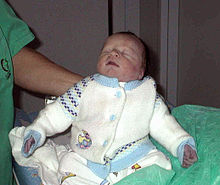|
Double inlet left ventricle
A double inlet left ventricle (DILV) or "single ventricle", is a congenital heart defect appearing in 5 in 100,000 newborns, where both the left atrium and the right atrium feed into the left ventricle. The right ventricle is hypoplastic or does not exist. Both atria communicate with the ventricle by a single atrio-ventricular valve. There is a big shunt left-right with a quickly evolutive pulmonary hypertension. Without life-prolonging interventions, the condition is fatal, but with intervention, the newborn may survive. Even if there is no foetal sickness, the diagnosis can be made in utero by foetal echocardiography. PresentationInfants born with DILV cannot feed normally (breathlessness) and have difficulty gaining weight. The mixed blood in systemic circulation leads to hypoxia (lack of oxygen to the body and organs), so infants develop cyanosis and breathlessness early.[citation needed] Diagnosis
Treatment
Usually, DILV is associated with other cardiac malformations. PrognosisMortality is very high in the first 2 years, 85%, but after it decreases and between 2 and 15 years old the mortality is only around 9%. Diagnosis must be made within few days or even hours to prevent death.[citation needed] References
External links |
||||||||||
Portal di Ensiklopedia Dunia
